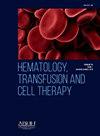Mir-4421可能通过erp29调控咽癌中mapk / akt通路
IF 1.8
Q3 HEMATOLOGY
引用次数: 0
摘要
引言/理由ERP29基因编码一种对蛋白质折叠和分泌至关重要的伴侣蛋白。我们之前的研究发现,ERP29抑制与咽癌(PC)风险增加和患者生存率降低有关,这可能是由于microRNA miR-4421与ERP29信使RNA(mRNA)之间的结合亲和力。这种相互作用会导致ERP29沉默,从而影响PC的进展,特别是通过减少坏死和增加细胞迁移。本研究旨在探讨 miR-4421 和 ERP29 在 PC 生存和进展中的作用。材料与方法我们首先使用 Kaplan-Meier Plotter(kmplot.com/analysis/)评估了 ERP29 和 miR-4421 在头颈癌患者中的预后价值。我们在两种不同的情况下使用 PC FaDu 细胞系(ATCC):FaDu顺铂(CDDP)敏感型和FaDu CDDP耐药型(FaDu-R)。使用特异性 siRNA 沉默了 ERP29 的表达。我们分别通过 TaqMan 平板阵列和定量 PCR(qPCR)鉴定和验证了 FaDu 和 FaDu-R 细胞中受 ERP29 调节的基因。我们检测了 miR-4421 抑制剂能否逆转ERP29 的沉默效应,并通过 qPCR 分析了 FaDu 和 FaDu-R 细胞中的基因表达。结果较低的ERP29(p = 0.03)和较高的miR-4421(p < 0.01)表达量与头颈癌患者的总生存率较低有关。与表达ERP29的细胞相比,在FaDu细胞中沉默ERP29会增加MAPK1(FC:2.4,p = 0.03)、AKT1(FC:17.5,p < 0.01)和JUN(FC:29.0,p = 0.01)的表达。相反,转染 miR-4421 抑制剂后,与阴性对照相比,MAPK1(FC:0.6,p = 0.03)、AKT1(FC:0.1,p = 0.02)和 JUN(FC:0.1,p = 0.02)的表达量减少,从而逆转了这些影响。在 FaDu-R 细胞中,与表达 ERP29 的细胞相比,沉默 ERP29 会增加 SOS1(FC:2.2,p = 0.01)、MAPK1(FC:2.1,p = 0.01)和 AKT1(FC:2.2,p = 0.04)的表达。相反,与阴性对照相比,miR-4421 抑制剂降低了 SOS1(FC:0.2,p = 0.03)、MAPK1(FC:0.4,p = 0.01)和 AKT1(FC:0.2,p = 0.04)的表达。然而,通过抑制 miR-4421 与 ERP29 的结合可以逆转这些影响。我们的研究加深了人们对PC进展和CDDP耐药性的理解,希望我们的发现有助于通过确保ERP29的表达来开发针对PC患者的靶向疗法。致谢本研究得到了国家科学与技术发展委员会(CNPq)的资助(资助编号:140019/2020-0、307944/2022-0、和 408177/2023-3)和圣保罗州教育与科研基金会(FAPESP 资助号 2023/12810-9)--癌症治疗创新中心(CancerThera)(CEPID FAPESP 资助号 2021/10265-8)的支持。本文章由计算机程序翻译,如有差异,请以英文原文为准。
MIR-4421 AS A POSSIBLE MODULATOR OF MAPK/AKT PATHWAY THROUGH ERP29 IN PHARYNGEAL CANCER
Introduction/Justification
ERP29 gene encodes a chaperone protein essential for protein folding and secretion. Our previous study linked ERP29 inhibition to an increased risk of pharyngeal cancer (PC) and reduced patient survival, possibly due to the binding affinity between microRNA miR-4421 and ERP29 messenger RNA (mRNA). This interaction leads to ERP29 silencing, which may influence PC progression especially by decreasing necrosis and increasing cell migration. However, the precise mechanism underlying this process remains unknown, particularly its impact on well-established signaling pathways such as MAPK/Akt, which are frequently dysregulated in PC and play a critical role in tumor progression, cell survival, and metastasis.
Objectives
This study aims to explore the role of miR-4421 and ERP29 in PC survival and progression.
Materials and Methods
We first evaluated ERP29 and miR-4421 prognostic value in head and neck cancer patients assessing the Kaplan–Meier Plotter (kmplot.com/analysis/). We used PC FaDu cell line (ATCC) in two different scenarios: FaDu cisplatin (CDDP)-sensitive and FaDu CDDP-resistant (FaDu-R). ERP29 expression was silenced using a specific siRNA. We identified and validated genes modulated by ERP29 in FaDu and FaDu-R cells by TaqMan plate array and quantitative PCR (qPCR), respectively. We tested if miR-4421 inhibitor could reverse ERP29 silencing effect, with gene expression analyzed by qPCR in FaDu and FaDu-R cells. Statistical analysis was performed by t-test using SPSS 21.0 software (SPSS Incorporation, USA).
Results
Lower ERP29 (p = 0.03) and higher miR-4421 (p < 0.01) expressions were associated with poor overall survival in head and neck cancer patients. In FaDu cells, ERP29 silencing increased MAPK1 (FC: 2.4, p = 0.03), AKT1 (FC: 17.5, p < 0.01), and JUN (FC: 29.0, p = 0.01) expression when compared to cells expressing ERP29. In contrast, the transfection of miR-4421 inhibitor reverted those effects, decreasing the expression of MAPK1 (FC: 0.6, p = 0.03), AKT1 (FC: 0.1, p = 0.02), and JUN (FC: 0.1, p = 0.02) compared to the negative control. In FaDu-R cells, ERP29 silencing increased SOS1 (FC: 2.2, p < 0.01), MAPK1 (FC: 2.1, p < 0.01), and AKT1 (FC: 2.2, p = 0.04) expression when compared to cells expressing ERP29. Conversely, miR-4421 inhibitor decreased the expression of SOS1 (FC: 0.2, p = 0.03), MAPK1 (FC: 0.4, p = 0.01), and AKT1 (FC: 0.2, p = 0.04) compared to the negative control.
Conclusion
Inhibition of ERP29 expression may impact MAPK/Akt pathway, contributing to PC patients’ poor survival. However, these effects could be reversed by inhibiting the binding of miR-4421 to ERP29. Our study enhances the understanding of PC progression and CDDP resistance, and we hope that our findings will aid in the development of targeted therapy for PC patients by ensuring ERP29 expression.
Acknowledgements
The study was supported by Conselho Nacional de Desenvolvimento Científico e Tecnológico (CNPq grant numbers 140019/2020-0, 307944/2022-0, and 408177/2023-3) and Fundação de Apoio ao Ensino e à Pesquisa do Estado de São Paulo (FAPESP grant number 2023/12810-9) - Cancer Theranostics Innovation Center, (CancerThera) (CEPID FAPESP grant number 2021/10265-8).
求助全文
通过发布文献求助,成功后即可免费获取论文全文。
去求助
来源期刊

Hematology, Transfusion and Cell Therapy
Multiple-
CiteScore
2.40
自引率
4.80%
发文量
1419
审稿时长
30 weeks
 求助内容:
求助内容: 应助结果提醒方式:
应助结果提醒方式:


